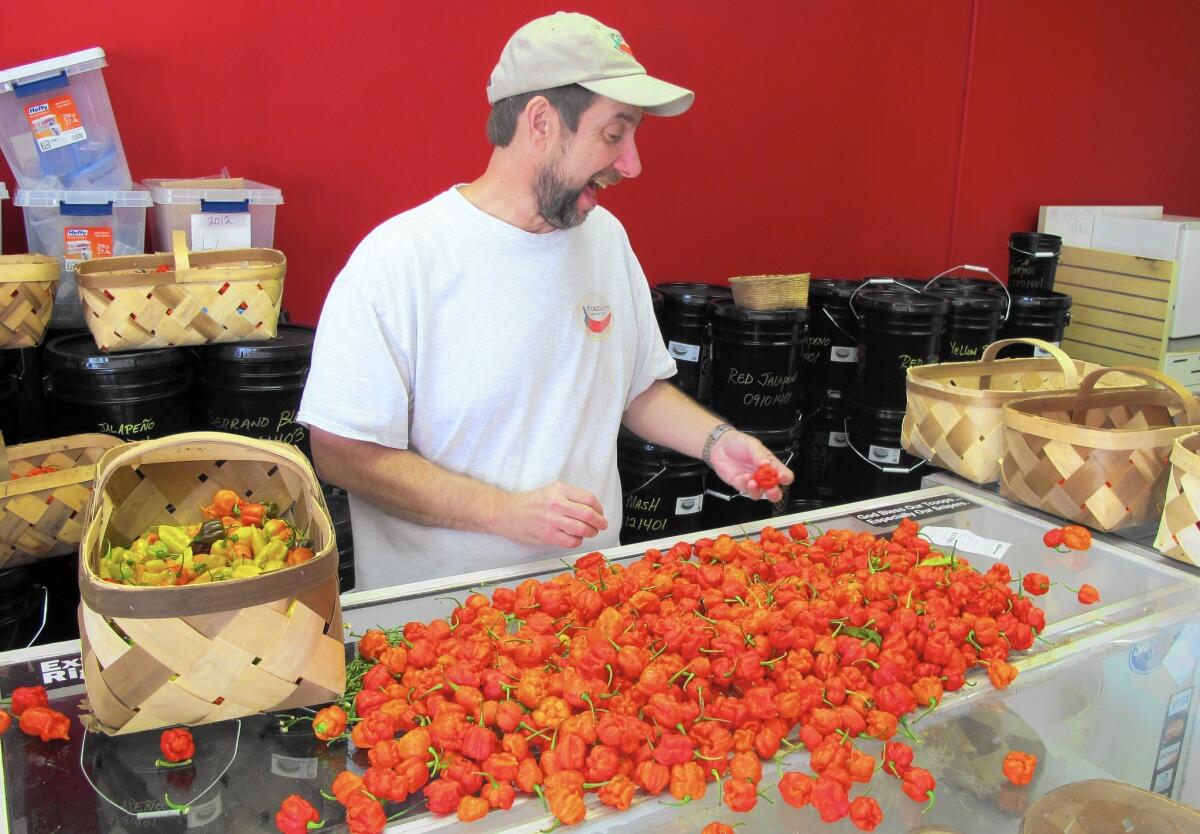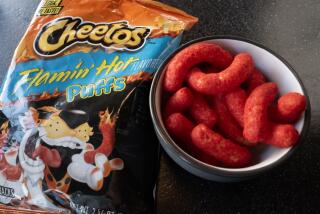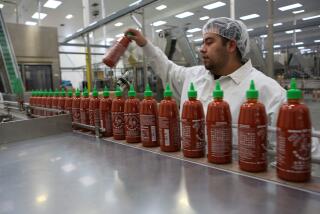From pot to hot: How a grower produced world’s most fiery chile pepper

- Share via
Reporting from FORT MILL, S.C. — How hot is Smokin’ Ed’s Carolina Reaper chile pepper?
It’s so hot that when you walk into the chile sorting room at Ed Currie’s PuckerButt Pepper Co., your eyes burn and your throat tightens from the sizzling fumes of hundreds of freshly picked peppers.
It’s so hot that workers who peel the chiles to scrape out seeds wear two pairs of protective gloves because the chile oils eat through one pair in 15 minutes.
Smokin’ Ed’s Carolina Reaper is the world’s hottest chile pepper, according to the Guinness World Records.
At a searing 1.56 million Scoville heat units, the Reaper knocked off the Trinidad Scorpion Butch T from Australia, the previous record holder at 1.46 million SHUs. (A very hot jalapeno might reach 10,000 SHUs.)
Chile heat rankings may seem trivial, but it’s a burning issue for purveyors of chile sauce, hot sauce, salsa and other fiery concoctions. After Guinness crowned the Reaper the champ one year ago, sales at PuckerButt soared — an eightfold increase over last year, Currie said.
Currie celebrated the anniversary last week by chowing down on a plump Carolina Reaper, one of eight to 10 “weapon quality” peppers he said he eats whole every day.
“Agh … I’m … losing … the … ability … to … talk,” Currie said as he gasped.
His throat was on fire. His face was blood red. His eyes watered. He choked down the rest of the Reaper and gulped a cold seltzer. “Eating them whole like that is just stupid,” he said.
Currie recovered after several minutes of gasping, choking and stomach cramps. “But it still hurts,” he reported, wolfing down pastrami turkey to cool his stomach.
A new PuckerButt employee, Joe Visser, did not fare as well. Seconds after Visser chewed up a fat Reaper, his lips were on fire and his face was contorted. He repaired to a restroom with severe abdominal distress.
Currie, 51, has been fascinated with crossbreeding plants since he was a boy in Michigan. He read library books about plants and pored over horticulture magazines ordered by his mother, a master gardener.
Currie, stocky and bearded, is a frenetic talker. He resembles the rumpled character actor Paul Giamatti and could probably play a mad scientist in a movie.
“My interest in chemistry years ago was drug-related, but it led me to peppers,” he said.
While boozing and drugging his way through several colleges, he said, he parlayed his self-taught crossbreeding skills into producing potent marijuana plants. “Anybody can do it,” he said of crossbreeding plants. “All you do is follow the scientific method.”
He began crossbreeding peppers after reading scientific papers suggesting that their chemical compounds might reduce the risk of heart attacks and cancer, two diseases that run in his family, Currie said.
“I wanted to find out how not to die,” he said. “I wanted to keep on partying.”
Currie has been clean and sober for nearly 16 years after completing a substance abuse recovery program in Michigan, he said.
In 2001, he moved to South Carolina and began working as a bank trust officer. At home, he made salsas and hot sauces from peppers he grew in his yard. That helped Currie woo and wed his wife, who loves salsa. She later persuaded him to sell his salsas rather than give them away to a growing number of friends and neighbors.
Currie opened a small booth at a flea market. Two years ago, he opened a storefront location on Main Street in downtown Fort Mill.
A year before his pepper set the record, Currie quit his bank job to concentrate full time on PuckerButt, named after his wife’s description of the effects of eating his salsa. The 8-year-old company sells salsa, hot sauce, chile seeds as well as chile jellies, chocolates, peanut brittle and brownies to customers worldwide.
Among the more popular sauces: Edible Lava, Ben’s Smokin’ Hot Razz Booty, I Dare You Stupit. Some products are made from the Reaper, whose off-label uses include “settling old scores,” Currie said.
It took 12 years of crossbreeding for Currie to reach the pinnacle of the pepper world. He said he tested hundreds of hybrid combinations before finally crossing a “really nastily hot” La Soufriere pepper from the Caribbean island of St. Vincent and a Naga pepper from Pakistan to create Smokin Ed’s Carolina Reaper — “a tidal wave of scorching fire,” as the PuckerButt website puts it.
In his fourth year of Reaper breeding — it takes years for hybrids to reproduce and stabilize — Currie asked a friend to taste the emerging hybrid. “He took a bite and fell to his knees and threw up, so I knew I had something,” Currie said.
He has seeds from 428 pepper hybrids he has produced, Currie said. He can’t remember how many others he has crossbred. “You have to remember I was drunk for part of that time,” he said.
Stomping through one of his pepper fields outside Fort Mill, Currie carries on a nonstop discourse about each hybrid planted among long rows of peppers. He discusses sun, soil, nutrients and taste.
The peppers are shapely and alluring: orange, red and green spheres glowing in the late autumn sunshine. Currie stops and caresses several plants. A devout Christian, he names each new hybrid with a number and the designation H.P., for God’s higher power.
Currie loves to banter with “Michigan Chris” Redding, a store employee who sat, double-gloved, at a table while stripping out seeds from a heap of orange Reapers. The conversation turned to how a man might safely use the restroom after handling hundreds of flaming hot Reapers.
“Tongs,” Redding explained.
Currie is a natural contrarian who insists on doing things his peculiar way, so it took him more than two years to fill out Guinness paperwork. “I don’t follow directions well,” he said.
Finally, Currie submitted 15 pages of scientific documentation, based on years of Reaper testing by chemists at Winthrop University in South Carolina. Their certified average Scoville heat unit of 1.56 million — from a rating procedure invented by American pharmacist Wilbur Scoville in 1912 — was ultimately accepted by Guinness.
“Too darn hot for me to taste,” said Cliff Calloway, a chemistry professor at Winthrop who tested the Reaper for more than five years using gas chromatography. In fact, he said, just the Reaper fumes and residue on his lab gloves were too hot for him.
The Reaper is the hottest pepper he has ever tested, Calloway said. The human body responds to the chemical “heat” from the Reaper as if it were burned with a match, he said.
Currie said a subclass of capsaicinoid compounds in peppers bind to taste receptors in the tongue. “It tricks the body into thinking it’s being burned,” he said. “Your body signals that as heat.”
Before the Guinness record, Currie said, business was so slow that he had to lay off 24 employees. But last November, he received an email from Guinness confirming his triumph. He dropped to his knees, sobbing. Somebody called an ambulance, fearing he’d suffered a heart attack.
Currie grows more than 15,000 chile pepper plants at 30 sites in North and South Carolina, plus sites in four other states, and at his home. He treats plot locations as state secrets for fear competitors will sneak in and steal his peppers. So-called chiliheads are a contentious lot, arguing incessantly about whose chile is hottest, Guinness notwithstanding.
“It’s a dog-eat-dog world,” said Wendy Hamilton of the Chile Pepper Institute at New Mexico State University, whose researchers declined to comment on the Carolina Reaper because they said their testing had not been completed.
Currie is ready for any assault on his Guinness record. He’s produced eight other hybrids even hotter than the Reaper, he said. The hottest averages 2.83 million SHUs in scientific lab testing, he said, far higher than the Reaper’s 1.56-million rating.
He’s holding the hybrids in reserve. If anyone tries to break his record, he’ll introduce one of them with documentation to reclaim the crown, he said.
The hottest hybrid — the name is top secret — “tastes awful,” Currie said. “It has a few seconds of flavor, and then the heat builds and builds and just doesn’t let up.”
Forty minutes after chewing one, he was still gulping water, he said. Hours later, he awoke at 2 a.m. “with an awful gut ball” — debilitating stomach cramps.
Currie said he’s tasted the hottest new hybrid more than 50 times.
Why?
“I’m stupid,” he said.
Twitter: @davidzucchino
More to Read
Sign up for Essential California
The most important California stories and recommendations in your inbox every morning.
You may occasionally receive promotional content from the Los Angeles Times.














